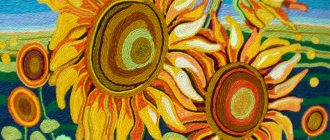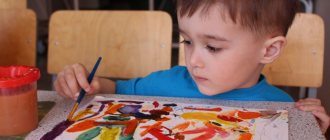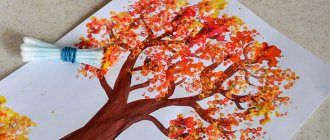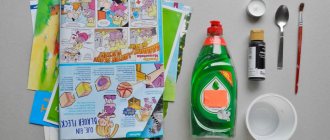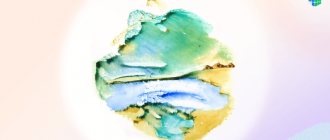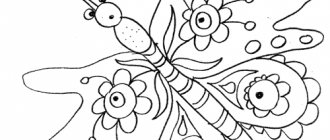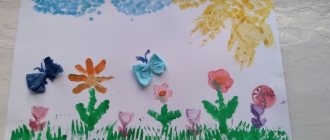Nitography is a drawing technique for children where woolen threads are used to embody an artistic image. The design can be made in several ways: by soaking the threads with paint and sliding it over the paper, laying out the appliqué according to the pattern, and also using stamps. In kindergarten, classes on non-traditional drawing techniques are held in the middle and senior groups, that is, with children 4–6 years old.
The benefits of learning different drawing techniques
Drawing for children is the first creative activity. Artistic activities contribute to the formation of a versatile, harmonious personality. They train fine motor skills and prepare hands for writing, teach attention to detail and concentration.
There are many drawing techniques, but non-traditional ones are considered especially useful for children. Creating drawings with palms, soap bubbles, stamps, threads and other original methods in childhood is much easier and more fun than with a pencil or brush. Having mastered various techniques, the child begins to think more broadly and can more accurately depict the intended image on paper.
Methodical album of non-traditional drawing samples for young children
Methodical album of non-traditional drawing samples for young children
Technique
"Finger painting"
Drawing method
:
the child dips his finger in the gouache and puts dots and spots on the paper. Each finger is painted with a different color. After work, wipe your fingers with a napkin, then the gouache is easily washed off.
Subject
: It’s raining, it’s raining more...
( drawing raindrops
)
Technique
"Finger painting"
Subject
: Rowan sprig (
drawing berries
)
Drawing method
:
the child dips his finger in the gouache and puts dots and spots on the paper. Each finger is painted with a different color. After work, wipe your fingers with a napkin, then the gouache is easily washed off.
Technique
"Palm drawing"
. Subject
: Funny octopuses (
drawing of octopuses
)
Drawing method
:
a child dips his palm (the entire brush) into gouache or paints it with a brush (with the help of an adult, from the age of five himself) and makes an imprint on paper. Draw with both right and left hands, painted in different colors
Technique
"Palm drawing"
Subject
: Hedgehog (
drawing needles
)
Drawing method
:
a child dips his palm (the entire brush) into gouache or paints it with a brush (with the help of an adult, from the age of five himself) and makes an imprint on paper. Draw with both right and left hands, painted in different colors
Technique “Drawing with cotton swabs”
Subject
: It's snowing (
drawing snow
)
Drawing method
:
the child dips a stick into the gouache and applies dots and spots. First, you can draw along the contour, and then fill the entire drawing with dots. For each new paint, take a new stick
Technique “Drawing with cotton swabs”
Subject
: Outfit for the Christmas tree (
drawing balls, garlands
)
Drawing method:
the child dips a stick into the gouache and applies dots and specks. First, you can draw along the contour, and then fill the entire drawing with dots. For each new paint, take a new stick
Technique
"Foam rubber imprint"
Subject
: Fluffy snowflakes (
snowflake drawing
)
Drawing method
:
the child presses the foam rubber onto a stamp pad with paint and makes an impression on the paper. To change the color, use another bowl and foam rubber.
Technique
"Foam rubber imprint"
Subject
: Feathers for chickens (
drawing plumage
)
Drawing method
:
the child presses the foam rubber onto a stamp pad with paint and makes an impression on the paper. To change the color, use another bowl and foam rubber.
Technique
"Cork imprint"
Drawing method:
the child presses the cork to the stamp pad with paint and makes an imprint on the paper. To obtain a different color, both the bowl and the stopper are changed.
Subject
: Flower for mom (
drawing a flower
)
Technique
"Cork imprint"
Subject
: Caterpillar (
drawing a caterpillar
)
Drawing method:
the child presses the cork to the stamp pad with paint and makes an imprint on the paper. To obtain a different color, both the bowl and the stopper are changed.
Technique
“Poke with a hard semi-dry brush”
Drawing method:
the child dips the brush into the gouache and hits the paper with it, holding it vertically. When working, the brush does not fall into the water. Thus, the entire sheet, outline or template is filled. The result is an imitation of the texture of a fluffy or prickly surface.
Subject
: Teddy bear (
drawing fur)
Technique
“Poke with a hard semi-dry brush”
Subject
: Mimosa sprig (
drawing flowers
)
Drawing method:
the child dips the brush into the gouache and hits the paper with it, holding it vertically. When working, the brush does not fall into the water. Thus, the entire sheet, outline or template is filled. The result is an imitation of the texture of a fluffy or prickly surface.
Technique
“Imprint with potato signets”
Drawing method:
The child presses the signet onto a stamp pad with paint and makes an impression on the paper. To obtain a different color, both the bowl and the signet are changed.
Subject
: First leaves (
drawing leaves
)
Technique
“Imprint with potato signets”
Subject
: Starry sky (
drawing stars
)
Drawing method:
The child presses the signet onto a stamp pad with paint and makes an impression on the paper. To obtain a different color, both the bowl and the signet are changed.
Description of the nitcography technique
Drawing with thread and paint is remarkable for its simplicity and unusualness. The resulting images are abstract. In them you can see the Firebird, a flower, sea waves, a whirlwind. Children use their imagination and thereby develop their creative imagination.
The following fairy tale-story describes the technique in an interesting and accessible way:
“Once upon a time there was a thread. She was completely alone. One fine day the thread decided to go for a walk. The weather was wonderful - the yellow sun was warm, the grass was green, and fluffy white clouds were frolicking in the blue sky. And she liked the picture around her so much that she wanted to transfer everything to a sheet of paper. But the trouble is, the thread did not have a friend - a pencil and a friend - a brush. Then she decided and plunged into the bright paint herself. A thread jumped onto the paper, and immediately the sun, grass and perky clouds appeared on it!”
There are different techniques for creating designs using threads. Let's look at each separately.
Drawing with threads
The “magic thread” drawing technique fully lives up to its name. With just one simple movement of the hand, a picture appears on the paper. Why isn't it magic?
The essence of the method is to use thread instead of a brush. It is saturated with paint, but the drawing is not displayed, but is obtained in a slightly different way:
- The woolen thread is dipped into a container of paint.
- When the thread gains color, it is placed between two sheets of paper. The pictures will be more interesting if you lay the rope in a zigzag.
- Then, lightly pressing the paper, the thread is pulled out. It leaves an intricate mark that can be added to or cut out and used as applique.
Examples of pictures drawn with threads and paints:
To obtain a multi-colored print, paint is poured into a container (flat and long, such as a soap dish) in strips of different colors. The thread is saturated with red, blue, yellow, and green at the same time.
Drawing with stamps
The use of threads in non-traditional drawing techniques is quite extensive. Another way to get an image is to dip a thread stamp into paint and attach it to a sheet of paper.
For the lesson you will need:
- base for the stamp - a wooden or foam block, a square of plasticine, thick cardboard;
- wool threads (thick yarn);
- PVA glue;
- brush and paints.
PVA glue is applied to the base according to the intended pattern (star, spiral, animal figurine). The thread is carefully laid out along the intended line. As soon as the stamp dries, the thread is saturated with paint.
You can do without glue by simply winding the ropes around the beam, or make prints immediately with a ball soaked in paint. To obtain an imprint, the seal is applied to a sheet of paper.
Illustrative examples:
